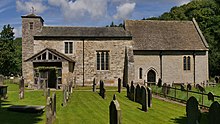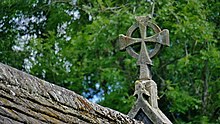St Gregory's Minster
St Gregory's Minster is an Anglo-Saxon church in the valley Kirkdale in the county of North Yorkshire in the region of Yorkshire and the Humber in England near the belonging to Kirkbymoorside town Welburn. It was built in 1060 instead of a previous building and has a rare sundial . The church is one of the Most Important Buildings with Grade I status on the UK Official List of Monuments .
The minster is dedicated to Gregory the Great . He was Pope from 590 to 604 , is considered to be one of the most important popes and is the youngest of the four great Latin Fathers of the Church in Late Antiquity. As with comparable churches of this age, numerous repairs and alterations have been carried out over the centuries.
The upkeep and construction of the church is supported by The Friends of St Gregory's Minster group .
location
The church is in the Kirkdale Valley in the middle of a large cemetery. Although the valley itself was never inhabited, it was the center of many settlements in the area until 1866. Kirkdale Cave, famous for the finds of prehistoric animal bones, is close to the church . The church can be reached by car and is usually open during the day.
description
Building history
The origins of the minister are obscure. Bede reported in his Historia ecclesiastica gentis Anglorum in 731 that a small community of monks settled under royal protection near Lastingham in 659 , possibly to prepare a burial place for Æthelwald , the king of Deira, in a trackless moorland where predators and wild animals ruled . The memory of the holy place seems to have survived the Danelag , as the church, specifically today's main nave, was rebuilt in 1065. Two tombstones from the 10th century were also built into the south wall.
In the 12th century, the doorway in the west wall was replaced by the current one (now leading into the tower) and the north aisle was built for the growing population before famine and the plague halved the population. The southeast entrance for priests and the masonry of the east window date from the 13th century.
These were taken over when the choir was rebuilt in 1881. At the same time, in the style of the time, glass windows were installed in the east wall and in the north wall of the aisle. Overall, the newly built choir appears disproportionately large compared to the tower and the nave. The last major renovation took place between 1907 and 1909. Fixtures from the Georgian era such as the gallery and the church stalls with individual seats were removed to give the church its medieval appearance.
Interior
In the church there are two Anglo-Saxon tombstones from the 8th and 9th centuries. They came to the church as part of the 1907 renovation. The font from the 13th century is right by the entrance. The organ came into the church in 1923 and was made by Abbott Smith in Leeds in 1910. There is an Anglo-Saxon tombstone in the vestibule. The church door dates from the 12th century.
sundial
On the south side of the church above the entrance door and now under the vestibule there is a canonical sundial that is labeled with the canonical hours instead of normal hours. The sundial is the best preserved of several similar churches in the area, as it was under plaster for 700 years and was only rediscovered in 1771 when the porch was built.
There are two inscriptions on the sundial itself:
+ ÞIS IS DÆGES SOLMERCA + / ÆT ILCVM TIDE
This is the sun marker at all times
+7 HAǷARÐ ME ǷROHTE 7 BRAND / PRS
and haward has mr and brand priests
Next to the sundial there is a stone on the left and right with the following inscription:
+ ORM GAMAL / SVNA BOHTE SCS / GREGORIVS MIN / STER ÐONNE HI / T ǷFS ÆL TOBRO // CAN 7 TOFALAN 7 HE / HIT LET MACAN NEǷAN FROM / GRVNDE ΧΡE 7 SCS GREGORI / VS IN EADǷARD DAGVM CNG / 7 [I] N TOSTI DAGVM EORL +
Orm the son of Garmal buys St. Gregory's Minster when it was all destroyed and collapsed and caused everything to be made from scratch for Christ and St. Gregory in the days of King Edward and in the days of Count Tosti.
tower
The medieval-looking tower was added to the church in 1827. Two medieval bells hang in it . The smaller Gregory bell was cast around 1300, the Peter bell around 1500. Both bells were restored in 1998.
See also
- Saint Nicholas Church (Bransdale)
- All Saints, Kirkbymoorside
- Saint Mary's Church (Lastingham)
- Saints Peter and Paul Church (Pickering, North Yorkshire)
- Ryedale Folk Museum with an exhibition of Anglo-Saxon stones
- Beck Isle Museum
literature
- Additional sheet with a description of the church
- Kirkdale churches
- Kirkdale churches - Church history
- English Churches - North Yorkshire
- St Gregory's Minster, Kirkdale ,
- Achurchnearyou.com
Web links
Coordinates: 54 ° 15 ′ 47 " N , 0 ° 57 ′ 46" W.









